 |
 |
 |
 |
 |
 |
| |
 |
|
 |
 |
 |
  |
  |
 |
 |
 |
 |
|
|
 |
|
 |
 |
 |
BUILDING |
 |
|
 |
|
 |
 |
 |
| |
 |
| 
 |
MuCEM J4 - Musée des Civilisations de l'Europe et de la Méditerranée
Museum of Civilisations from Europe and the Mediterranean |
|
 |
 |
 |
 |
DESIGNER |
 |
|
|
 |
|
 |
 |
 |
| |
 |
|
 |
 |
 |
 |
CONTEXT |
 |
|
|
 |
|
 |
 |
 |
| The complex of the interventions |
 |
|
 |
- 40,000 m2 over three sites
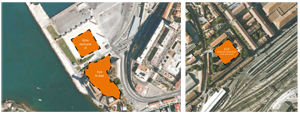 Three sites, three settings, with multiple and surprising offerings over a total of 40,000 m2: the MuCEM will be a true museum of the 21st century, capable of attracting diverse audiences through a very wide range of activities. The public can of course explore the major exhibitions in the galleries of the new museum, but also enjoy a lecture, a concert, public discussions, film screenings... or simply enjoy the ambiance of the city by walking through the Mediterranean gardens of the rehabilitated Fort Saint-Jean. The MuCEM will be a place for living, open to all, well beyond its must see exhibitions and events. Three sites, three settings, with multiple and surprising offerings over a total of 40,000 m2: the MuCEM will be a true museum of the 21st century, capable of attracting diverse audiences through a very wide range of activities. The public can of course explore the major exhibitions in the galleries of the new museum, but also enjoy a lecture, a concert, public discussions, film screenings... or simply enjoy the ambiance of the city by walking through the Mediterranean gardens of the rehabilitated Fort Saint-Jean. The MuCEM will be a place for living, open to all, well beyond its must see exhibitions and events.
- A visit in three stages, rich in discoveries and wonders
The new museum built on the former J4 port pier by the architect Rudy Ricciotti will be the heart of the MuCEM. A place dedicated to the discovery of the major stages of Mediterranean civilisations, addressing themes as striking as the invention of gods, the treasures of the spice route, the visions of Jerusalem, the citizens’ banquet or the curiosity cabinet on the seven wonders of the world.
The public will then pass through the arcades and vaulted rooms hidden in the stone recesses of Fort Saint-Jean, a historic monument dating from the 12th century. Via a suspended footbridge, cast over the sea, visitors will enjoy spectacular and previously unseen panoramas. Here the visitor can stroll in the new Mediterranean garden and marvel at the riches of the popular and folk art collections of the MuCEM.
A third site located in the Belle de Mai district, near the Saint-Charles railway station, will house the Centre for Conservation and Resources (CCR), designed by architect Corinne Vezzoni. A facility for the conservation of the collections, the CCR will also offer opportunities to visit behind the scenes of the museum. It will host a space recounting the history of the museum, also open to the public.
| J4 |
15.000 m2 |
including 3,600 m2 of exhibition space |
| Fort Saint-Jean |
15.000 m2 |
including 1,150 m2 of exhibition space |
| CCR |
10.000 m2 |
including 7,000 m2 of storage facilities |
|
|
1.400 m2 of space open to the public |
|
|
100 m2 of exhibition space |
- The J4: the heart of the MuCEM
Between city and sea, on the former J4 port pier, the building of 15,000 m2, designed by architect Rudy Ricciotti in collaboration with Roland Carta contains more than 3,600 m2 of exhibition space, dedicated areas for children, an auditorium with 325 seats for the presentation of lectures, performances, concerts, film series, a bookstore, a brasserie and a restaurant boasting a panoramic terrace and “behind the scenes“ all that is indispensable to a facility of this type: workshops, storage areas, offices, etc. |
|
 |
 |
 |
 |
 |
 |
 |
DESCRIPTION |
 |
|
|
 |
|
 |
 |
 |
|
|
 |
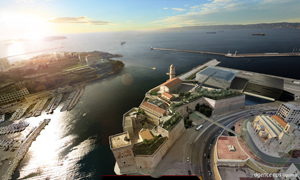 Winner of the international competition for these two projects launched in 2002, over seven other teams, Rudy Ricciotti – with RCT Architects Associés – designed an eminently discrete and refined project that gives way to the fort and the Old Port. Positioned at the entrance of the pass, it converses with the earth, sky and sea. Here, the bombastic has no place. The architect who has always practised in the Var, opposes respect and continuity with a personal and political view on a territory that he knows well, and through which he accentuates the highpoints of civilisation. Neither modern nor trendy, refusing to arbitrate between its membership in the East or the West, and yet perfectly contemporary, his project takes an intuitive and sensorial approach in relation to the environment and the material. Based on a square footprint of 72 metres per side imposed by the developer, the volume is fixed in the landscape by a fine openwork lattice positioned to the south, the west and on the roof, framing a second parallelepiped of 52 metres per side and of 18 metres in height constituting the body of the museum. Between the two run the ramps for circulation unwinding in the manner of a ziggurat up to the panoramic terrace. The museum offers a shared environment: minerality, basic geometry, climatic filter... To the ancestral stone of the fort replies the contemporary concrete in its state-of-the-art technological expression that lends all its subtlety to the work. Winner of the international competition for these two projects launched in 2002, over seven other teams, Rudy Ricciotti – with RCT Architects Associés – designed an eminently discrete and refined project that gives way to the fort and the Old Port. Positioned at the entrance of the pass, it converses with the earth, sky and sea. Here, the bombastic has no place. The architect who has always practised in the Var, opposes respect and continuity with a personal and political view on a territory that he knows well, and through which he accentuates the highpoints of civilisation. Neither modern nor trendy, refusing to arbitrate between its membership in the East or the West, and yet perfectly contemporary, his project takes an intuitive and sensorial approach in relation to the environment and the material. Based on a square footprint of 72 metres per side imposed by the developer, the volume is fixed in the landscape by a fine openwork lattice positioned to the south, the west and on the roof, framing a second parallelepiped of 52 metres per side and of 18 metres in height constituting the body of the museum. Between the two run the ramps for circulation unwinding in the manner of a ziggurat up to the panoramic terrace. The museum offers a shared environment: minerality, basic geometry, climatic filter... To the ancestral stone of the fort replies the contemporary concrete in its state-of-the-art technological expression that lends all its subtlety to the work. |
|
 |
 |
 |
|
 |
|
| The conceptual framework of the project, by Rudy Ricciotti |
 |
|
 |
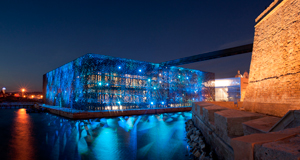 Views, sea, sun, a mineral quality, which all must be orchestrated by a program that will become federal and cognitive. First of all a perfect square of 72 m per side, it is a classic plan, Latin, under the control of Pythagoras. Within this square, another of 52 m per side, comprising the exhibition and conference halls identified as the heart of the museum. Views, sea, sun, a mineral quality, which all must be orchestrated by a program that will become federal and cognitive. First of all a perfect square of 72 m per side, it is a classic plan, Latin, under the control of Pythagoras. Within this square, another of 52 m per side, comprising the exhibition and conference halls identified as the heart of the museum.
Around, above and below are the service areas. But between these areas and the heart, openings entirely bypass the central square and form interconnected spaces. More interested by the views of the fort, the sea or the port, the culturally overwhelmed visitor will choose this route. Along two interlacing ramps, he will then plunge into the imaginary of the tower of Babel or of a ziggurat in order to climb up to the rooftop and on to Fort Saint- Jean. This peripheral loop will be a demuseumifying breathe, enveloped by the smells of the sea from the proximity to the moats, a pause to dispel any lingering doubts about the use of the history of our civilisations. The MuCEM will be a vertical Casbah.
The tectonic choice of an exceptional concrete coming from the latest research by French industry, reducing the dimensions to little more than skin and bones, will affirm a mineral script under the high ramparts of Fort Saint-Jean. This sole material in the colour of dust, matt, crushed by the light, distant from the brilliance and technological consumerism, will commend the dense and the delicate. The MuCEM sees itself evanescent in a landscape of stone and Orientalist through its fanning shadows.
In the sky spanning the basin a flying carpet, granted a bit long, navigates towards the fort. |
|
 |
 |
 |
|
 |
|
| Two major exhibition plateaux |
 |
|
 |
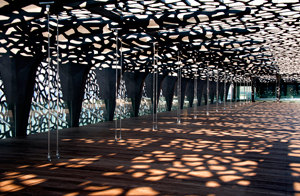 The J4 building will host the major exhibitions of the MuCEM on two levels: The J4 building will host the major exhibitions of the MuCEM on two levels:
> Level 1: 1,600 m2 in the Gallery of the Mediterranean
Located on the ground floor, the thematic gallery will be dedicated to the singularities of the Mediterranean world in all its diversity and complexity. This gallery which addresses selected themes will be adjustable in its layout and will be designed to be changed in the medium term (3 to 5 years).
> Level 2: 2,000 m2 of temporary exhibition space
The flexibility of the spaces offers each exhibition a suitable space, between 300 m2 and 2,000 m2, the number of annual exhibitions ranging from three to five. |
|
 |
 |
 |
 |
 |
 |
 |
MATERIALS |
 |
|
|
 |
|
 |
 |
 |
 |
 |
|
concrete, glass 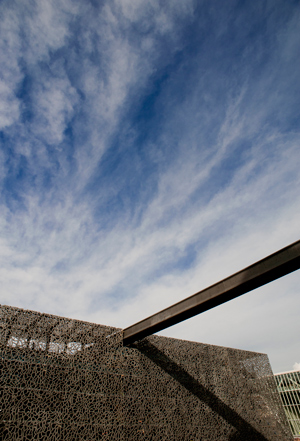 Due to his experience with the Seoul footbridge, in Korea, in 2000, Rudy Ricciotti has relied since 2002 on UHPC (fibre-reinforced ultra high performance concrete), a revolutionary material which at the time few architects had the experience to implement. This latest generation of concrete with a granular perfectly compact composition that is similar to stone, represents the constructive style chosen by the designer as a feature common to the civilisations of Europe and the Mediterranean. From the simple device of Cyclopean stones which retain the earth to the ancient concrete of the Romans, a city is erected. Due to his experience with the Seoul footbridge, in Korea, in 2000, Rudy Ricciotti has relied since 2002 on UHPC (fibre-reinforced ultra high performance concrete), a revolutionary material which at the time few architects had the experience to implement. This latest generation of concrete with a granular perfectly compact composition that is similar to stone, represents the constructive style chosen by the designer as a feature common to the civilisations of Europe and the Mediterranean. From the simple device of Cyclopean stones which retain the earth to the ancient concrete of the Romans, a city is erected.
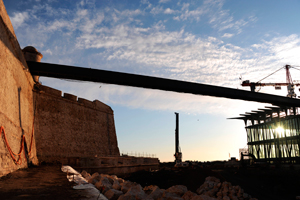 Fibre-reinforced ultra high performance concrete resulting from French research, consists of aggregates, fibres and a binder. Its composition gives it three essential qualities: a compressive strength 6 to 8 times superior to conventional concrete, a perfect seal, and a capacity to mould the most diverse casts. As its name indicates, it contains metallic and/or synthetic fibres thinner than a strand of hair that also provide excellent performance under traction. This product with “closed pores”, air and watertight – not to mention resistant to sea spray and chemical attack- is as suitable for the project design as for a maritime context. Through its components and prefabrication in a workshop near Montpellier, it is naturally suited to an environmental and sustainable approach, promising a longevity of hundreds of years. Fibre-reinforced ultra high performance concrete resulting from French research, consists of aggregates, fibres and a binder. Its composition gives it three essential qualities: a compressive strength 6 to 8 times superior to conventional concrete, a perfect seal, and a capacity to mould the most diverse casts. As its name indicates, it contains metallic and/or synthetic fibres thinner than a strand of hair that also provide excellent performance under traction. This product with “closed pores”, air and watertight – not to mention resistant to sea spray and chemical attack- is as suitable for the project design as for a maritime context. Through its components and prefabrication in a workshop near Montpellier, it is naturally suited to an environmental and sustainable approach, promising a longevity of hundreds of years.
During the gestation of the MuCEM, the architect had the opportunity to experiment on other projects, particularly with the Pont du Diable footbridge in Saint-Guilhem-du-Désert, or the roof of the Villa Navarra in Le Muy. These diverse experiences have enabled him to better understand the potential of this new material and its implementation. Thus the MuCEM footbridge is emulative of that of the Pont du Diable, though of a broader span. On the other hand, companies have been using UHPC for twenty years for specific works: chemical storage tanks, structures, siding products, small components like stairs and facade panels... The stakes for the MuCEM, as Rudy Ricciotti has announced, are to test the qualities of these new concretes in the design of an entire building, an important accomplishment that meets all the regulatory requirements for public buildings while affirming an expression.
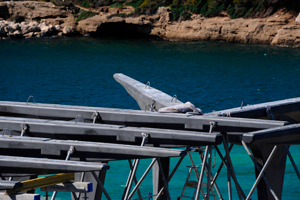 No matter the form, the site prevails. The landscape is arid, eroded by the salt and subjected to the forces of the wind. Dehydration hollows bodies. Stripped of the superfluous and deaf to discourse, the project retains the essential: the colour, the sparkle of the water, the heat and the spray. The construction evades interpretation and formalism to compose a field of experience. The work is deliberately bare and exposed. Simple, just the necessary, raw; the material is minimal: glass and concrete, or in the words of the architect, “skin and bones”. The proposal emerges as a truth revealed. Rudy Ricciotti cleans the slate of the archetypes of construction. The bearers draw themselves a little closer to the efforts. The poured mix of sand and cement is liberated from the standard profile and geometry. The mathematics are physical, thought is body, nature and culture are no longer opposed. No matter the form, the site prevails. The landscape is arid, eroded by the salt and subjected to the forces of the wind. Dehydration hollows bodies. Stripped of the superfluous and deaf to discourse, the project retains the essential: the colour, the sparkle of the water, the heat and the spray. The construction evades interpretation and formalism to compose a field of experience. The work is deliberately bare and exposed. Simple, just the necessary, raw; the material is minimal: glass and concrete, or in the words of the architect, “skin and bones”. The proposal emerges as a truth revealed. Rudy Ricciotti cleans the slate of the archetypes of construction. The bearers draw themselves a little closer to the efforts. The poured mix of sand and cement is liberated from the standard profile and geometry. The mathematics are physical, thought is body, nature and culture are no longer opposed.
The concrete is liberated from gravity to become a precious mantilla suspended at a distance from the facades. The architect shapes the material and frames the hollows. It is in this bare space that he invites the visitor to appreciate the forces present. The inserted void vacuums the surrounding environment. It is nourished by the horizon and makes legible the distance to Fort Saint-Jean, offering a view and an experience. Acclimating the heat and the glare, the skin of latticework projects on the floor the imprint of vanished materials. The entire site is there, powerful. The shooting intensity of the structure and the voluptuous curves of the frame support it, building a work which is primitive and intimate, quasi gothic and sensual.
The work on this piece of architecture is becoming grounded. Poles, latticework, footbridge are the resolution.
The design of the elements passes through the interior of the forms, an invisible thing which must be taken into account.
The engineer’s work begins.
- The preconstrained, force field
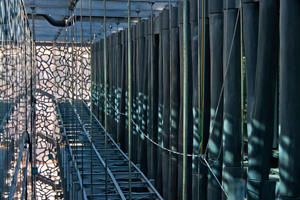 The use of UHPC is experimental in the construction of a facility open to the public. The MuCEM is the first building to use vertical preconstrained structures. With no previous experience to draw from, we must construct hypotheses with the CSTB (French Scientific and Technical Centre for Building) to find adapted computation software, particularly because the proposed forms are complex. The use of UHPC is experimental in the construction of a facility open to the public. The MuCEM is the first building to use vertical preconstrained structures. With no previous experience to draw from, we must construct hypotheses with the CSTB (French Scientific and Technical Centre for Building) to find adapted computation software, particularly because the proposed forms are complex.
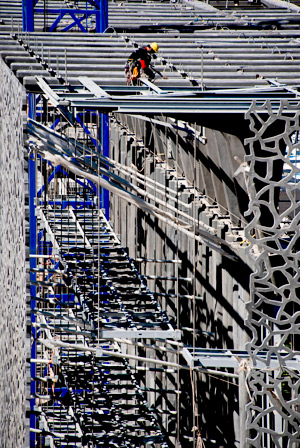 In the case of steel construction with linear material, the constraints are proportional to the deformations. The structural element is straight and behaves the same way in tension and in compression. In the case of UHPC, the material behaves differently in traction and in compression, the law of behaviour varies depending on the level of deformation of the material. We must therefore follow the curves throughout their development taking into account their section, cylindrical for the poles, trapezoidal for the latticework. The poles are not straight and under the action of the off-centre charges from the floors, they bend. This deformation is called buckling. In order to control the phenomenon, cables passing through shafts traverse the elements– horizontally for the footbridge, vertically for the poles – over the entire structure and are tensioned at their extremities by means of jacks. This technique assembles the independent prefabricated elements and brings them together to construct a coherent structure, arborescent poles in several branches, the footbridge composed of voussoirs... The preconstraint consists of using the formidable capacity of the material to work in compression to compensate for its weakness relative to traction by anticipating a sufficient initial compression so that the concrete remains entirely compressed under the stress. The poles and the footbridge will borrow the technique of preconstraint by post-tensioning while the flooring will be created according to the process widely used in construction of precast concrete preconstrained by pre-tension with elements of 23 metres in length. In the case of steel construction with linear material, the constraints are proportional to the deformations. The structural element is straight and behaves the same way in tension and in compression. In the case of UHPC, the material behaves differently in traction and in compression, the law of behaviour varies depending on the level of deformation of the material. We must therefore follow the curves throughout their development taking into account their section, cylindrical for the poles, trapezoidal for the latticework. The poles are not straight and under the action of the off-centre charges from the floors, they bend. This deformation is called buckling. In order to control the phenomenon, cables passing through shafts traverse the elements– horizontally for the footbridge, vertically for the poles – over the entire structure and are tensioned at their extremities by means of jacks. This technique assembles the independent prefabricated elements and brings them together to construct a coherent structure, arborescent poles in several branches, the footbridge composed of voussoirs... The preconstraint consists of using the formidable capacity of the material to work in compression to compensate for its weakness relative to traction by anticipating a sufficient initial compression so that the concrete remains entirely compressed under the stress. The poles and the footbridge will borrow the technique of preconstraint by post-tensioning while the flooring will be created according to the process widely used in construction of precast concrete preconstrained by pre-tension with elements of 23 metres in length.
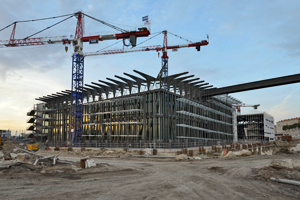 The engineer works according to regulations. Here he had to anticipate the new seismic zoning put in effect on 1st May 2011, more stringent for Marseille, and evaluate the behaviour of the structures under fire conditions. In total, eight ATEX (Technical Experimental Assessment) were necessary to validate the innovations developed for this building. The ATEX replaces the technical evaluation, ATEC (Avis Techniques) when the calculation methods are not subject to approved regulations. Prototypes were manufactured for this purpose and tests conducted in the laboratories of CSTB. The analysis of the results enables the validation of the hypotheses and verification that the calculations are representative of reality. The engineer works according to regulations. Here he had to anticipate the new seismic zoning put in effect on 1st May 2011, more stringent for Marseille, and evaluate the behaviour of the structures under fire conditions. In total, eight ATEX (Technical Experimental Assessment) were necessary to validate the innovations developed for this building. The ATEX replaces the technical evaluation, ATEC (Avis Techniques) when the calculation methods are not subject to approved regulations. Prototypes were manufactured for this purpose and tests conducted in the laboratories of CSTB. The analysis of the results enables the validation of the hypotheses and verification that the calculations are representative of reality.
Thus, the poles were subjected over their entire height to temperatures of 1000 degrees on one side and of 20 degrees on the other for 90 minutes to control the deformation. A huge requirement.
Originally preconstrained by the height of one level of the building, these poles ensuring the bracing have been adapted to seismic risk by a preconstraint expanded to the entire building by means of ball-and-socket joints articulated at the top and bottom. An invention of the engineer, Eugène Freyssinet, this joint was the subject of an ATEX to define its dimensions. This extremely rigorous development took some time, postponing the fabrications accordingly. For reasons of timing, the building will be assembled in reverse. Usually, the concrete poles are cast on a level to allow the construction of the upper floor on which it rests and the operation is repeated as many times as there are floors. The construction of the MuCEM takes a different path. The preconstrained concrete floors will be built on supports independent of the poles. Once the installation of all these elements is completed, the floors will be connected to the columns and the supports dismantled one by one moving from the upper floors to the ground floor. Preconstraining by post-tension enables a process such as this.
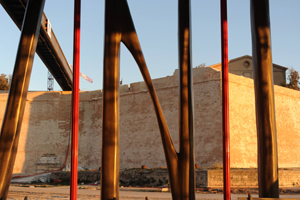 The realization of this original structure involves a long chain of expertise ranging from concrete chemists and structural engineers (Jacques Portelatine) to businesses, by way of a succession of prefabrication and preconstraint specialists. A technological challenge was undertaken with the utilisation of UHPC, of which a page is being written today. To each prefabricated piece there corresponds a studied casing. A designer (Philippe Deplagne) creates the form in wood by sculpting according to the indications of the architect. The sensual character of the work comes from this intervention. These outlines in wood enable the creation of the casts. Furthermore, UHPC is costly and the economy of material is desired. The poles of 9 metres with a diameter of 40 cm, a footbridge spanning 76 metres between supports for a profile not exceeding 1.80 metres in height, the latticework of the facade in panels of 6 by 3 metres and only 7 cm thick... The knowledge of engineering, the quality of fabrication, the precision of the implementation are absolutely linked, as each architectural piece is at once structure and finite expression, an ultimate optimisation of the mechanical proprieties of the material. The different experimental technical evaluations and the experiences of other projects in progress open the way for future regulation. The realization of this original structure involves a long chain of expertise ranging from concrete chemists and structural engineers (Jacques Portelatine) to businesses, by way of a succession of prefabrication and preconstraint specialists. A technological challenge was undertaken with the utilisation of UHPC, of which a page is being written today. To each prefabricated piece there corresponds a studied casing. A designer (Philippe Deplagne) creates the form in wood by sculpting according to the indications of the architect. The sensual character of the work comes from this intervention. These outlines in wood enable the creation of the casts. Furthermore, UHPC is costly and the economy of material is desired. The poles of 9 metres with a diameter of 40 cm, a footbridge spanning 76 metres between supports for a profile not exceeding 1.80 metres in height, the latticework of the facade in panels of 6 by 3 metres and only 7 cm thick... The knowledge of engineering, the quality of fabrication, the precision of the implementation are absolutely linked, as each architectural piece is at once structure and finite expression, an ultimate optimisation of the mechanical proprieties of the material. The different experimental technical evaluations and the experiences of other projects in progress open the way for future regulation.
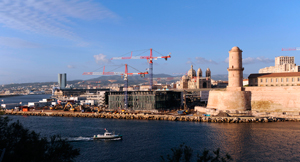 Another dimension of the project is economic. The UHPC is a patented process and the project manager, the Ministry of Culture, asked CSTB to test the various products currently available, Ductal from Lafarge, BSI from Eiffage and BCV from Vicat, so that the call for bids would not result in a restricted tender. Tests were conducted allowing the validation of the mechanical properties of each product. Today the sector is sufficiently large, from manufacturers to installers, so that competition can occur. Another dimension of the project is economic. The UHPC is a patented process and the project manager, the Ministry of Culture, asked CSTB to test the various products currently available, Ductal from Lafarge, BSI from Eiffage and BCV from Vicat, so that the call for bids would not result in a restricted tender. Tests were conducted allowing the validation of the mechanical properties of each product. Today the sector is sufficiently large, from manufacturers to installers, so that competition can occur.
The group selected under the auspices of Vinci consists of the company Dumez for the structural work (Eric Tollini), de Freyssinet (Jérôme Coupy, François Téply) for the design, installation and tensioning of the elements in Ductal and Bonna Sabla (Patrick Mazzacane) for prefabrication. The engineering consulting firms are Structure Ile de France (Joseph Attias and Hachem Bechara) for the infrastructure and Lamoureux & Ricciotti Engineering (Guillaume Lamoureux and Romain Ricciotti) for the UHPC and the long floor spans.
Each enterprise brings its own know-how and expertise, backed by teams proud to participate in this grand adventure comparable to that of the CNIT at La Défense.
The millimetric precision of the cast pieces and their manufacturing complexity is a matter for specialists. The tensioning cables are passed after installation and each branch of a pole could possibly be an obstacle if solutions are not found. From the rigorous installation, to the ad hoc tools for adjusting the elements along the three axes XYZ, and the union of the prefabricated elements to the beams cast in place to lower tolerances, each action is scrupulous. The development of the latticework for the facade and roof and the fluidity of the building plan could substantiate the idea of simplicity, this is not the case. Of the 308 poles in 20 different versions, very few in reality will be identical. Their positioning in angles or in the centre of the floors changes their internal characteristics.
If the idea of simplicity persists, it must recognise the strength and the fragility of each work, the common spirit in the design of the latticework and its support, the evidence of the assemblies, the work in perfect collaboration of the design and implementation teams.
 The footbridge of 115 metres in length, without arches or cable-stays, connects the terrace of the new building to Fort-Saint-Jean. To the classic design of a crossing element consisting of an assembly of beams, of cross-pieces, of a deck is substituted an addition of all these components into a single form, moulded and monolithic, a mechanical optimum favouring the long lifespan of the work. Twenty-five voussoirs of 4.5 metres long prefabricated in a workshop will be assembled by post-tension. The footbridge of 115 metres in length, without arches or cable-stays, connects the terrace of the new building to Fort-Saint-Jean. To the classic design of a crossing element consisting of an assembly of beams, of cross-pieces, of a deck is substituted an addition of all these components into a single form, moulded and monolithic, a mechanical optimum favouring the long lifespan of the work. Twenty-five voussoirs of 4.5 metres long prefabricated in a workshop will be assembled by post-tension.
They thus form two beams, guard rails, drawn closer to the effort. The ensemble has a height of 1.80 m and crosses a length of 76 m between intermediate piers then 2 times 18 m on each lateral span. The contact surfaces between voussoirs are vital and the accepted tolerance of the prefabrication is on the order of 1/10th of a mm and 1/10th of a degree.
A device for shock absorption was placed under the footbridge.
- 13,297 m3 of concrete and 1,680 m3 of concrete for the precast flooring of C60
- 233 units of precast flooring of C60 (18T/unit)
- 711 m3 of UHPC concrete
- 1,162 tons of steel
- 309 poles in UHPC 20 different casts 2.89 m to 8.79 m in height with diameters of 25 to 40 cm, on the 4 facades of the building
- 384 panels of latticework of UHPC, 1,500 m2 of latticework
|
|
 |
 |
 |
 |
BUSINESS ENTERPRISES |
 |
|
|
 |
|
 |
 |
 |
| Construction materials |
 |
|
 |
|
 |
 |
 |
 |
ECO-SUSTAINABILITY |
 |
|
|
 |
|
 |
 |
 |
| Architecture and sustainability |
 |
|
 |
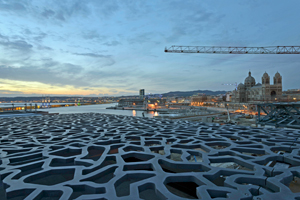 Research on environmental quality is integrated into the construction, not just as talk or justification, but as a dimension of the act of building. The technical provisions for cooling air through the intake of sea water, and the reduction in the overall height of the building limiting the solar exposure of the facades obtained by using preconstrained concrete to reduce the thickness of the floors, are insufficient invocations for translating the perspectives of this new method of construction. The work of Rudy Ricciotti pleads for a “dematerialisation and a physicality” (territory, material economy, expressiveness). The method of fabrication favours a sector which amplifies an environmental posture of short chains of production in which the conditions of transport are reduced and the labour needs are favoured for economic and social sharing, from not outsourcing highly skilled jobs to production in situ. The MuCEM will be monochrome and black to exist in the light of the site. Proximity with the constructed form and sincerity of the material, seeking intimacy, architecture is the endeavour of our community, that which we want to build. Research on environmental quality is integrated into the construction, not just as talk or justification, but as a dimension of the act of building. The technical provisions for cooling air through the intake of sea water, and the reduction in the overall height of the building limiting the solar exposure of the facades obtained by using preconstrained concrete to reduce the thickness of the floors, are insufficient invocations for translating the perspectives of this new method of construction. The work of Rudy Ricciotti pleads for a “dematerialisation and a physicality” (territory, material economy, expressiveness). The method of fabrication favours a sector which amplifies an environmental posture of short chains of production in which the conditions of transport are reduced and the labour needs are favoured for economic and social sharing, from not outsourcing highly skilled jobs to production in situ. The MuCEM will be monochrome and black to exist in the light of the site. Proximity with the constructed form and sincerity of the material, seeking intimacy, architecture is the endeavour of our community, that which we want to build. |
|
 |
 |
 |
|
 |
|
| Energy production |
 |
|
 |
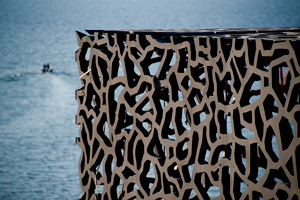 Since the beginning of the study phase it was envisioned to implement an ecological system of production to meet the energy needs of the MuCEM and reduce the consummation of energy. Since the beginning of the study phase it was envisioned to implement an ecological system of production to meet the energy needs of the MuCEM and reduce the consummation of energy.
The proximity to the sea suggested that the production for the heating and cooling of the premises could be addressed through to a system of pumping/discharge of seawater supplying the thermo-refrigeration equipment. The principal of a heat pump is a thermodynamic system that exploits a natural resource operating between two sources, cold and hot. The transfer of energy occurs from the cold source to the hot source, via a refrigerant.
The change of state of this refrigerant (used in a closed circuit, thus with no risk of polluting sea water) which may either be evaporated or condensed depending on the season, enables the production of the hot or cold water necessary for the MuCEM’s air handling system. The only impact on the seawater is the variation in temperature between the intake and discharge which varies +5°C in summer and – 5°C in winter.
The impact of the water source heat pump on the greenhouse effect is a reduction from 2.5 to 4 of the CO2 emissions necessary for the production of energy.
Our environmentally responsible system has drawn the attention of the PACA Regional Council, project manager of the Centre Régional de la Méditerranée (CEREM), our neighbouring building, which wanted to connect with our system. In order to maximize the profitability of the installations and to go as far as possible with this eco-responsible approach, from a simple mutualisation of pumping sea water we have conjointly agreed to a common system of pumping and production, necessitating a 1st agreement apportioning the costs of the investment and a 2nd permitting the operation and maintenance of the installation during its functioning period.
On this basis, a declaration file of water policy was filed under article L 214-3 of the environmental code, and was subject to an agreement 7th November 2011.. |
|
 |
 |
 |
 |
 |
 |
 |
LOCATION |
 |
|
|
 |
|
 |
 |
 |

|
 |

|
Continent |
|
 |
|
Nation |
|
 |
|
Region |
|
 |
|
District |
|
 |
|
Town |
|
 |
|
Address |
|
 |
|
|
|
 |
|
Website |
|
 |
|
 |
 |
 |
 |
MAP |
 |
|
|
 |
|
 |
 |
 |
| |
 |
|
 |
 |
 |
 |
|
TYPOLOGY |
 |
|
|
 |
|
 |
 |
 |
Main |
 |
|
 |
ARCHITECTURE | Buildings for cultural activities
Art galleries and exhibition areas
Museums and buildings for exhibitions
Ethnographic museums
Transport buildings and structures
Bridges and walkways
| |
|
|
 |
|
Additional |
 |
|
 |
ARCHITECTURE | Buildings for cultural activities
Libraries and media libraries
Conference halls
Education buildings
Children's museums and pedagogical spaces
Auditorium
Buildings for offices and professional practises
Offices
Commercial buildings
Shops
Bars, cafeterias
Restaurants
| |
 |
 |
 |
 |
CHRONOLOGY |
 |
|
|
 |
|
 |
 |
 |
Project |
 |
|
 |
| 
 |
2004 - 2007
project winner of competition
|
|
Realisation |
 |
|
 |
| 
 |
2009 - 2013 |
|
 |
 |
 |
 |
THE BUILDING IN CINEMA |
 |
|
|
 |
|
 |
 |
 |
| Title |
 |
|
 |
| BAC Nord [The Stronghold]
|
|
| Directed by |
 |
|
 |
|
| Nationality |
 |
|
 |
|
| Year of production |
 |
|
 |
|
| Cast |
 |
|
 |
| Gilles Lellouche, Karim Leklou, François Civil, Adèle Exarchopoulos, Kenza Fortas, Cyril Lecomte, Michaël Abiteboul, Idir Azougli, Vincent Darmuzey, Jean-Yves Berteloot |
|
| Building's role |
 |
|
 |
|
 |
 |
 |
 |
 |
 |
 |
BIBILIOGRAPHIC REFERENCES |
 |
|
|
 |
|
 |
 |
 |
|
 |
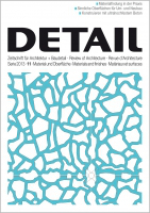 Frank Kaltenbach, "MuCEM in Marseille - Haut und Knochen aus ultrahochfestem Beton / MuCEM in Marseille - diaphanous and structural applications of UHPC [ultra high-performance concrete]", Detail 11/2013, november/november 2013 [Material und Oberfläche / Materials and finishes / Matériaux et surfaces], "Technik / Technology", pp. 1268-1276 Frank Kaltenbach, "MuCEM in Marseille - Haut und Knochen aus ultrahochfestem Beton / MuCEM in Marseille - diaphanous and structural applications of UHPC [ultra high-performance concrete]", Detail 11/2013, november/november 2013 [Material und Oberfläche / Materials and finishes / Matériaux et surfaces], "Technik / Technology", pp. 1268-1276 |
|
|
| Owen Pritchard, "MuCEM. Rudy Ricciotti", Icon 123, september 2013, pp. 44-45 |
|
|
| Andrew Ayers, "Coq of the walk. Rudy Ricciotti", Architectural Review 1398, august 2013, pp. 54-61 |
|
|
| Claudia Fuchs, "Marseille. Europaische Kulturhaupstadt 2013 / Marseille. European Capital of Culture 2013", Detail 6/2013, juni/june 2013 [Massive Bauten / Solid forms of Construction / Construction et masse], "Berichte / reports" pp. 610-613 |
|
|
| Philippe Donnaès, "Equipement culturel. Musée ultracomplexe en béton ultraperformant", Le Moniteur des Travaux Publics et du Bâtiment 5684, 2 novembre 2012, pp. 28-32 |
|
|
| Francesco Della Casa, "Belle de Mai, MUCEM, CEREM. Étendards culturels standards/non standards / Conventional and unconventional cultural standards", L'Architecture d'Aujourd'hui 389, mai-juin/may-june 2012, pp. 118-127 |
|
|
| "MUCEM, Marseille, 25 Janvier 2012 / MUCEM, Marseille, 25 January 2012", Moniteur Architecture AMC 212, february/février 2012, pp. 8-9 |
|
|
| "Al Forte Saint Jean / In Marseilles. Progetto: Rudy Ricciotti", L'Arca 226, giugno/june 2007, "l'Arca2" p. 91 |
|
|
| Denis Moreau, "Une boite noire echouee au bord de la Mediterranee: concours Mucem a Marseille / Musee des Civilisations de l'Europe & de la Mediterranee (MUCEM) competition, Marseille", L'Architecture d'Aujourd'hui 352, mai-juin/may-june 2004, pp. 90-109 |
|
|
| Elena Cardani, "Avventura demuseificante / MUCEM Marseilles", L'Arca 192, maggio/may 2004, pp. 62-67 |
|
|
| Sylvie Groueff, "8 projets pour le musee des Civilisations de l'Europe et de la Mediterranee a Marseille / Eight competition projects for the Musee dec Civilisations de l'Europe et de la Mediterranee (MUCEM), Marseille", D'Architectures 136, avril/april 2004, pp. 66-75 |
|
|
| Catherine Seron-Pierre, "Concours: equipement culturel national a Marseille / Competition: Musee des Civilisations de l'Europe & de la Mediterranee (MUCEM), Marseilles", Moniteur Architecture AMC 141, mars/march 2004, pp. 11-19 |
|
 |
 |
 |
 |
 |
 |
 |
CLIENT |
 |
|
|
 |
|
 |
 |
 |
| |
 |
Ministère de la Culture et de la Communication - Direction générale des patrimoines
OPPIC (Opérateur du patrimoine et des projets immobiliers de la culture) - Centre de conservation et de ressources (CCR) |
|
 |
 |
 |
 |
AMOUNT |
 |
|
|
 |
|
 |
 |
 |
| |
 |
|
 |
 |
 |
 |
DIMENSIONAL
DATA |
 |
|
|
 |
|
 |
 |
 |
| Surface |
 |
|
 |
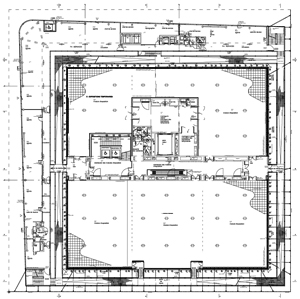 Net habitable space 15.718 m2 Net habitable space 15.718 m2
Spaces for presentations: 3,690 m2 including:
- Permanent exhibitions: 1,600 m2
- Temporary exhibitions: 2,000 m2
- Hybrid library: 90 m2
Public reception: 1,787 m2
Commercial spaces:
- Restaurant: 1,100 m2
- Bookstore: 285 m2
Forums - Conferences – Seminars: 1,100 m2
Cultural activities: 184 m2
Administration – Conservation – Research: 2,415 m2
General logistics: 3,694 m2 |
|
| Floors |
 |
|
 |
Total number of levels: 7, including 3 for the museum
- 5 superstructure levels
- 2 underground levels |
|
| Height |
 |
|
 |
|
| Capacity |
 |
|
 |
|
| Number |
 |
|
 |
| 10 elevators including 2 goods lifts |
|
| Lenght |
 |
|
 |
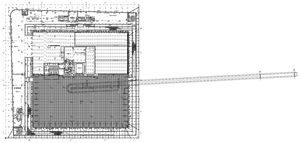 Footbridge J4 / Fort-Saint-Jean: Footbridge J4 / Fort-Saint-Jean:
- Length: 135 m with the return (76 m span between abutments)
Footbridge Fort Saint-Jean / Esplanade Saint Laurent:
- Length of 69 m between abutments
- Peripheral footbridge: 820 m |
|
| Weight |
 |
|
 |
Footbridge J4 / Fort-Saint-Jean:
Weight: 340 tons including the return |
|
 |
 |
 |
 |
STRUCTURES |
 |
|
|
 |
|
 |
 |
 |
| |
 |
|
 |
 |
 |
 |
LANDSCAPE DESIGN |
 |
|
|
 |
|
 |
 |
 |
| |
 |
|
 |
 |
 |
 |
STAFF |
 |
|
|
 |
|
 |
 |
 |
Project  |
 |
|
|
 |
|
Associate designers  |
 |
C+T architecture
Roland Carta |
|
|
 |
|
Graphic design |
 |
| Béatrice Fichet/Locomotion |
|
Hydraulic engineer |
 |
|
Consultant for energy and environment |
 |
|
Acoustical consultant |
 |
|
Lighting engineer |
 |
|
Museum consultant |
 |
|
Lighting design |
 |
|
Artistic and multimedia installations |
 |
|
Sound design |
 |
|
Graphics and signage |
 |
|
Quantity surveyor |
 |
|
 |
 |
 |
 |
ANNOTATIONS |
 |
|
|
 |
|
 |
 |
 |
| |
 |
Key dates
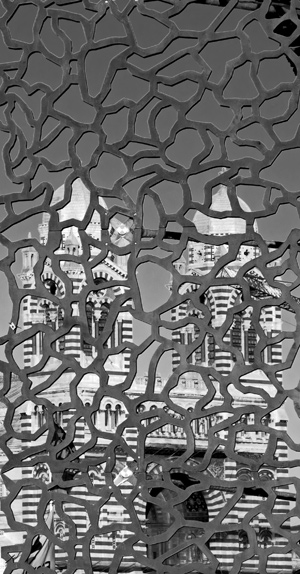 2000 2000
December: announcement of the creation of the museum in Marseille by the Minister of Culture and Communication, Catherine Tasca.
2002
Installation of a satellite office in Marseille responsible for organising exhibitions and establishing local partnerships.
2003
First prefiguration exhibition in Marseille, at Fort Saint-Jean, “Marseille/Algiers: At the mirror of memory”, as part of El Djazaïr 2003, The Year of Algeria in France. 300,000 visitors discover the fort thanks to fifteen prefiguration exhibitions held through 2010.
2004
February: Rudy Ricciotti/RTC Associates winner of the architectural design competition for the MuCEM site on the J4 pier.
September: Corinne Vezzoni and Associates, winners of the architectural design competition for the Centre for Conservation in the Belle de Mai; opening of the “chantier des collections” (the process of collection inventory/assessment/restoration) in Paris.
2005
Commencement of the restoration of the Saint-Jean chapel. June: Declaration by decree the “Museum of Civilisations from Europe and the Mediterranean” (MuCEM).
2006
Signing of the financing agreement between the State, the city of Marseille, the Department of Bouches-du-Rhône, and the Region Provence-Alpes-Côte d’Azur.
2007
Exhibition “Treasures of Daily Life” at Fort Saint-Jean. Restoration of the bell tower of Saint-Jean chapel. Launching of the public/private partnership process for the construction of the Centre for Conservation and Resources (Corinne Vezzoni).
2009
September: Establishment of an association for prefiguration of the museum with director, Bruno Suzzarelli, and president, Yves Aubin de la Messuzière.
November: Seminar on the reorientation of the MuCEM. Laying of the foundation stone for the J4 building by the Minister of Culture and Communication, Frédéric Mitterrand.
December: Signing of a public-private partnership with Icade for the construction of the Centre for Conservation and Resources.
Beginning of the restoration project on the ramparts and curtain walls of Fort Saint-Jean.
2010
The major programming decisions are made. Recruitment of ten staff members charged with preparations for the operation of the future establishment.
Acceleration of the “chantier des collections”.
September: Arrival of Zeev Gourarier, General Curator of Heritage and Scientific Director of the collections of the MuCEM.
October: Launching of the series of encounters “Tuesdays at the MuCEM”, at the Alcazar, the library of Marseille, with a regional focus.
November: Last prefiguration exhibition at Fort Saint-Jean: “Delicate Landscapes”. December: Beginning of construction of the Centre for Conservation and Resources.
2011
March: MuCEM international scientific meetings.
June: Choice of the museographic designer for the exhibition spaces of Fort Saint-Jean: Zette Cazalas
December: Choice of Studio Adeline Rispal for the exhibition design of the Gallery of the Mediterranean.
Completion of the major structural work of the J4 building and the CCR.
Continuation of museographic studies and designation of the project managers in charge of the temporary exhibitions in the J4 (“At the Bazaar of Gender” and “The Black and the Blue”).
May to September: Outdoor exhibition “Exquisite Pieces”, presented in the Espace Électra of the EDF Foundation in Paris.
November: Outdoor exhibition “Faire le Mur” presented at Lieu Unique in Nantes.
2012
June: MuCEM Premiere. The MuCEM is unveiled and welcomes the general public to the construction site on 30th June and 1st July.
November: Arrival at the CCR of the first collections.
2013
January: Exceptional opening on the occasion of the launching of Marseille-Provence 2013.
Spring: Inauguration of the MuCEM.
|
|
 |
 |
 |
 |
RELATED PROJECTS |
 |
|
|
 |
|
 |
 |
 |
| |
 |
|
 |
 |
 |
 |
CREDITS |
 |
|
|
 |
|
 |
 |
 |
| |
 |
Photos © Lisa Ricciotti, Olivier Amsellem
Drawings © Agence Rudy Ricciotti
Text edit by Claudine Colin Communication
Courtesy of Agence Rudy Ricciotti, Claudine Colin Communication, Association Marseille-Provence 2013
|
|
 |
  |
 |
|
|